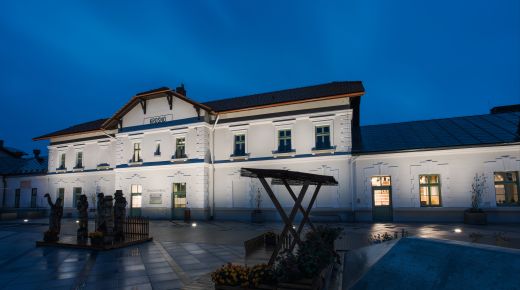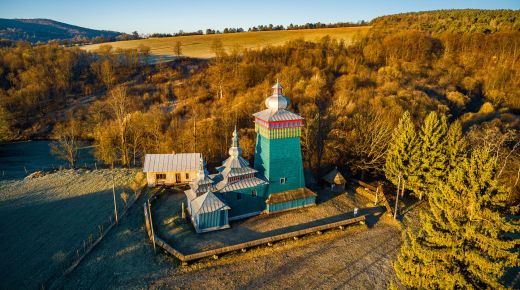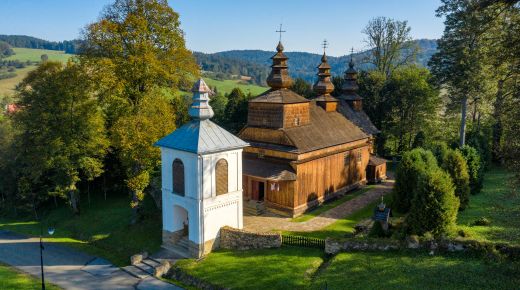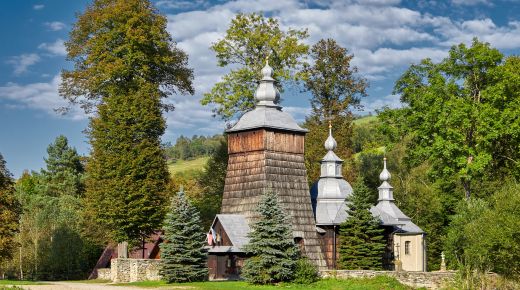Until the displacements that took place after World War II, the area of the Low Beskid was inhabited by the Lemkos - a group of nearly 100,000 Carpathian highlanders. They arrived here in the 19th century, were of Greek Catholic or Orthodox faith, and mainly engaged in shepherding, farming, but also in stonemasonry or woodcarving. Take a look where in the Low Beskid you can find Lemko heritage and traces of villages forcibly abandoned by this ethnic minority.
You should start your search in Zyndranowa, where, as if using a time machine, you will be transported to another - cultural, religious and linguistic - dimension. There is a Museum of Lemko Culture that collects objects characteristic of the Lemko region, such as an old Lemko hut - chyża, a former stable - koniusznia, smithy, windmill, pigsty, inn or chapel. While you're there, pay attention to the appearance of the cottages and the colorful sculptures, distinctive costumes, original old furniture, everyday objects, farm tools or utensils commonly used by the Lemkos displayed in the open-air museum. The special atmosphere of Lemkowyna can be experienced during outdoor painting workshops and events such as: "From Rusal to John".
![Zyndranowa G Joniec.webp [243.76 KB]](https://podkarpackie.travel/storage/image/core_files/2023/5/12/535b90e377464f110de01f570e75e6b8/webp/prot/preview/Zyndranowa%20G%20Joniec.webp) Museum of Lemko Culture in Zyndranowa, photo by G. Joniec
Museum of Lemko Culture in Zyndranowa, photo by G. Joniec
![Timur_Taran_Wosłok_Wielki_4823.webp [255.10 KB]](https://podkarpackie.travel/storage/image/core_files/2023/4/25/870d9fd61975fd16a56064c488ed05a4/webp/prot/preview/Timur_Taran_Wosłok_Wielki_4823.webp) Wisłok Wielki, photo by Timur Taran
Wisłok Wielki, photo by Timur Taran
From Zyndranowa - through Daliowa - it's worth heading to the non-existing Lemko village of Królik Wołoski to visit the restored Greek Catholic Church of the Transmission of the Relics of St. Nicholas the Baptist . This temple, hidden among the trees, was built of river stone in 1843. Next to the temple you can find a cemetery with 35 preserved tombstones made of sandstone in the shape of a cross. In turn, 200 meters south of the Orthodox church, on the left side of the main stream, stands among the bushes, by a small road, a chapel from 1794 - one of the oldest in the region.
The temples are most prominent manifestation of Lemko culture. Although some of them remain only mysterious-looking Orthodox churches, the landscape of the Low Beskids is still marked by churches topped with onion-shaped helmets, such as those under the sign of wooden architecture: in Krempna, Olchowiec, or colorful Orthodox churches-churches in Świątkowa Wielka and Świątkowa Mała. In Bałucianka, in turn, rises the Dormition of the Holy Mother of God Church, built around 1750, one of the oldest and best preserved in
Lemko Region. Inside, the iconostasis is surprisingly decorated with floral motifs characteristic of local Lemko woodcarving.
![Magdalena_Bodzek_Krempna_5002.webp [130.49 KB]](https://podkarpackie.travel/storage/image/core_files/2023/4/25/441a1d01e31fd72f8dac74775f3da925/webp/prot/preview/Magdalena_Bodzek_Krempna_5002.webp) Orthodox church in Krempna, photo by M. Bodzek
Orthodox church in Krempna, photo by M. Bodzek
![10 Bałucianka Cerkiew greckokatolicka pw. św. Zaśnięcia Przeświętej Bogarodzicy fot. Krystian Kłysewicz.webp [798.33 KB]](https://podkarpackie.travel/storage/image/core_files/2023/4/25/6190612ea48c629f4f29aad7b00a8c00/webp/prot/preview/10%20Bałucianka%20Cerkiew%20greckokatolicka%20pw.%20św.%20Zaśnięcia%20Przeświętej%20Bogarodzicy%20fot.%20Krystian%20Kłysewicz.webp) Greek Catholic Church of St. st. Dormition of the Most Holy Mother of God in Bałucianka, photo by K.Kłysewicz
Greek Catholic Church of St. st. Dormition of the Most Holy Mother of God in Bałucianka, photo by K.Kłysewicz
An important point on the trail of Lemko culture is the now defunct village of Wołtuszowa, located near Rymanów-Zdrój. In the midst of the forest, on a low hill, hidden in the shade of aged lindens and oaks, are the remains of the village, which before the war was inhabited by 149 residents. It's the perfect place for relaxing in nature and contemplation.
These are by no means the only places with the spirit of Lemkovyna. Also worth visiting:
- Wróblik Szlachecki and the former Dormition of the Mother of God church and Greek Catholic cemetery;
- Besko and the Orthodox church on a not-so-high hill overlooking the Wislok River winding below, and further on the Bukowica and Dział ranges in the Low Beskid;
- Odrzechowa - a cemetery with historic Lemko tombstones;
- Płonne - a village with the ruins of a brick Orthodox church, where an imitation of an iconostasis was created on one of the walls, and on the desks resembling an Orthodox tetrapod were placed pre-war photos of the villagers.Worth knowing:
Nowadays, Lemko identity is being revived in various regions of Poland. This is manifested, among other things, in the social and cultural activities of people of Lemko origin. The number of people declaring Lemko nationality is also growing (approximately 6,000 thousand in 2005 and nearly 10,000 in 2011)
USEFUL INFORMATION:
Museum of Lemko Culture
Museum of cultural heritage of Lemkos including ethnographic and historical exhibitions, as well as a collection of militaria - souvenirs of the 1944 Battle of the Dukla Pass.
Society for the Development of the Lemko Culture Museum
Zyndranowa 1, 38-454 Tylawa
tel. +48 13 433 07 12
Opening dates and times:
January-March: museum closed to the public;
April-October: 10 am - 4 pm;
October-December: from 9 a.m. to 3 p.m;
on Mondays the museum is closed to the public
Greek Catholic Church of the Holy Cross. Relocation of the Relics of St. Nicholas Church in Królik Wołoski
St. Nicholas Orthodox Church in Królik Wołoski is a brick parish Greek Catholic church. It is a stone church, covered with a gabled ridge roof covered with sheet metal, with three turrets set on octagonal drums.
Królik Wołoski Association
tel. +48 13 425 00 87
Opening Hours:
due to ongoing restoration work, currently the church can only be seen from the outside and visit the cemetery
Dormition of the Holy Mother of God Church in Bałucianka
A wooden Greek Catholic church, built around 1750.
Roman Catholic Parish of the Nativity of the Blessed Virgin Mary. Nativity of the Blessed Virgin Mary in Królik Polsk
Bałucianka 14, 38-481 Bałucianka
tel. +48 605 358 648
Opening Hours:
Facility open to the public by telephone appointment with the parish priest
"From Rusal to John"
Од Русаля до Яна
i.e. from Pentecost to St. John's Day
celebration of Lemko culture and tradition
Museum of Lemko Culture in Zydranova
Zyndranowa 1, 38-454 Tylawa
Date: annually at the end of July
*Rusala - is the Ruthenian Pentecost.
Dzikie wino
Agritourism and Social Cooperative in the Low Beskid in Daliowa, in the old khyzha rooms and inn
Social Cooperative "Dzikie Wino"
Daliowa 13L, 38-485 Jaśliska
tel. +48 501 739 963
Opening hours: best to check on Facebook Dzikie Wino





